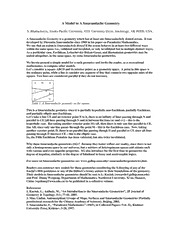
A Model to a Smarandache Geometry PDF
Preview A Model to a Smarandache Geometry
A Model to A Smarandache Geometry S. Bhattacharya, Alaska Pacific University, 4101 University Drive, Anchorage, AK 99508, USA. A Smarandache Geometry is a geometry which has at least one Smarandachely denied axiom. It was developed by Florentin Smarandache since 1969 in his paper on Paradoxist Mathematics. We say that an axiom is Smarandachely denied if the axiom behaves in at least two different ways within the same space (i.e., validated and invalided, or only invalidated but in multiple distinct ways). As a particular case, Euclidean, Lobachevsky-Bolyai-Gauss, and Riemannian geometries may be united altogether, in the same space, by some Smarandache geometries. We herein present a simple model for a such geometry and invite the reader, as a recreational mathematics, to compose other models. Let’s consider a square ABCD and its interior points as a geometric space. A point in this space is the ordinary point, while a line is consider any segment of line that connects two opposite sides of the square. Two lines are considered parallel if they do not intersect. A M B u v N E C D Table 1: A Smarandache geometry on the square. This is a Smarandache geometry since it is partially hyperbolic non-Euclidean, partially Euclidean, and partially elliptic non-Euclidean. Let’s take a line CE and an exterior point N to it, there is an infinity of lines passing through N and parallel to CE [all lines passing through N and in between the lines (u) and (v)] – this is the hyperbolic case. But taking another exterior point M0AB, then there is only one line parallel to CE, line AB, since only one line passes through the point M – this is the Euclidean case. Now, taking another exterior point, D, there is no parallel line passing though D and parallel to CE since all lines passing through D intersect CE – this is the elliptic case. So, the Fifth Euclidean Postulate has been validated, but also twice invalidated. Why these Smarandache geometries (SG)? Because they better reflect our reality, since there is not only a homogeneous space in our universe, but a mixture of heterogeneous spaces and axioms each with various and even opposite properties. SG also introduce for the first time in geometries the degree of negation, similarly to the degree of falsehood in fuzzy and neutrosophic logics. For more on Smarandache geometries see: www.gallup.unm.edu/~smarandache/geometries.htm. Readers can construct new models for these geometries considering the S-denying of any of the Euclid’s fifth postulates or any of the Hilbert’s twenty axioms in their foundations of the geometry. Their models to Smarandache geometries should be sent to L. Kuciuk ([email protected]) and Prof. Zhang Wenpeng, Department of Mathematics, Northwest University, Xi'an, Shaanxi, China ([email protected]) to be published in a collective volume. References: 1. Kuciuk, L., Antholy, M., “An Introduction to the Smarandache Geometries”, JP Journal of Geometry & Topology, 5(1), 77-81, 2005. 2. Mao, Linfan, Automorphism Groups of Maps, Surfaces and Smarandache Geometries (Partially postdoctoral research for the Chinese Academy of Sciences), Beijing, 2005. 3. Smarandache, F., “Paradoxist Mathematics” (1969), in Collected Papers (Vol. II), Kishinev University Press, Kishinev, 5-28, 1997.
